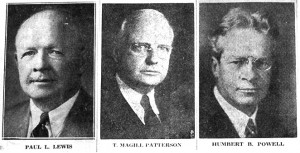The Lower Merion Water Company, which purchased the site of Martin’s Dam and a few acres surrounding it in 1890, from James Martin, son of Richard Martin, for whom the Dam was named, started to build a large red brick pumping station and also raised the original dam breast.
Whether the company ever intended to operate the pumping station is an open question. At any rate no machinery was ever installed in it, and it seems quite possible that the building of this pumping station was only a gesture on the part of the promoters to reassure stockholders of their good faith. On the face of the matter, it seems difficult to believe that the flow of water from the dam was ever sufficient to supply the needs of the lower Main Line.
In the meantime, farmers in the valley below the dam obtained a court injunction, halting the use of water for the purposes designated by the newly formed water company. Stocks and bonds had been sold far and wide, many even in England. Legend has it that the bonds were lost in transit by the sinking of a boat between this country and their ultimate destination.
The old Guaranty Title and Trust Company of Philadelphia was trustee for the bonds, with the firm of Morgan, Lewis and Bockius as attorneys.
In the end the promoters of this nebulous water company fled to Mexico and stockholders lost all the money they had put in the venture. It was not until the spring of 1936 that the legal entanglements of the situation were sufficiently cleared up to assure clear title to Martin’s Dam Club for its purchase of the property.
In the meantime George R. Park, a long time resident, who purchased the old Martin homestead for his family in 1906, saw the possibilities of the Dam as a swimming club. Several years before, a Mr. Kirby, from Radnor, had obtained a lease from Morgan, Lewis and Bockius, which Mr. Park now took over. Mr. Kirby had made some attempts at improvement of the property, one of them being the original platform on the site of the present diving platform. This was built on a foundation of solid masonry, placed in that location by the Water Company for some unknown purpose.
Mr. Park, who had a large family of his own to enjoy a good swimming place just across the road from their spacious home, soon established an informal club at this location. Many came here to enjoy swimming in the cool spring-fed waters of the Dam, some on the basis of annual membership, others by admission at the gate. What remained of the one-time brick pump house was used as a bathhouse.
According to Paul L. Lewis, of Strafford, now president of Martin’s Dam Club, the idea of the Club originated in his mind and that of T. Magill Patterson as “they sat together on a log over at the Dam one day.” Because their children and their neighbors’ children were experiencing the joys of a “good old swimming hole” these two men could envision the benefits to be derived from an organized Club for the residents of Radnor township and its general vicinity.
The first meeting of the Martin’s Dam Club was held early in May 1924, at the home of Mr. Patterson, on Midland avenue, in St. Davids. (Well does your columnist recall many admonitions of five small Pattersons gathered on the second floor “to be quiet because Dad is having a meeting in the living room.”)
Three other men had been invited to come to this organization meeting by those two who had “sat together on a log over at the Dam one day” not long before. They were Stanton C. Kelton, of St. Davids, and the late Humber B. Powell and Joseph F. Stockwell, both of Wayne. These five “organized” the Martin’s Dam Club for the purpose of operating “a restricted club for swimming and other sports.”
Mr. Powell was elected president, Mr. Lewis, secretary, and Mr. Patterson, treasurer. Mr. Powell held his office continuously from that spring of 1924 until his death in the summer of 1951, devoting much time to all the legal business of the club, particularly on the occasion of the eventual purchase of the property in 1936. Mr. Lewis has succeeded Mr. Powell as president, while still retaining his original office as secretary of the Club, and he has proved invaluable over the years.
Mr. Patterson relinquished his post of treasurer to his son-in-law, John B. Yerkes, of Bryn Mawr, in 1945 after more than 25 years of continuous service. Minutes of a meeting held in October, 1931 record the fact that “Mr. Patterson has devoted a great deal of time since the organization of the Club not only to his official duties as treasurer, but also has given more time and energy to the management of all the affairs of the Club than any other one member of the Club. During the past seven years, he has visited the club property almost daily during the swimming season, and has been mainly responsible for the satisfactory manner in which the club has operated and for the repairs and improvements which have been made. In addition, he has received innumerable telephone calls and letters in regard to membership in the Club.” Despite ill health, Mr. Patterson’s interest in the operation he helped to found still remains unabated.
To these five men, who came together 28 years ago this spring, the community owes the existence of a swimming club now numbering 625 memberships, the majority of which are for families. In addition, there is a waiting list, now of necessity confined to those living in the immediate vicinity.
(To Be Continued)
(Note: The picture used with last week’s column was that of the old brick pump house, and not that of the Hughes Mill as incorrectly stated in the caption.)

